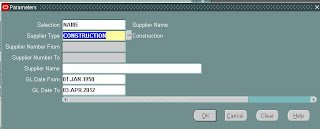This post is to list out different executable and corresponding data source available for XML publisher report.
System Administrator Responsibility -
Concurrent >> Program >> Executable >> Create Executable file
XML_LEARNING (Oracle Report Builder)
OA_LEARNING.XML_LEARNING (PL/SQL Stored Procedure)
XDODTEXE (Java Concurrent Porgram) <*** Standard program provided by Oracle>
Concurrent >> Program >> Define >> Create Program
Executable Name – should be as above
Output Format - XML
XML Publisher Responsibility -
Data Definition >> Create New data definition (code should be CP name)
Data Template File = Attached if data source is XML file and CP is Java concurrent program
Template >> Create a new template and attach the layout (RTF) file















